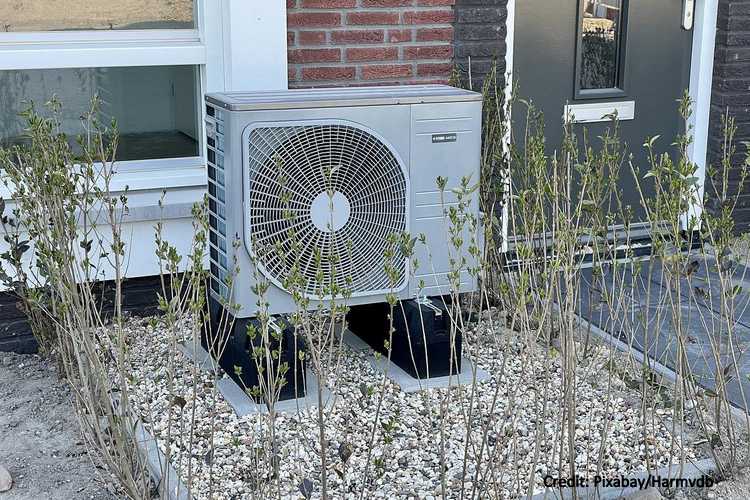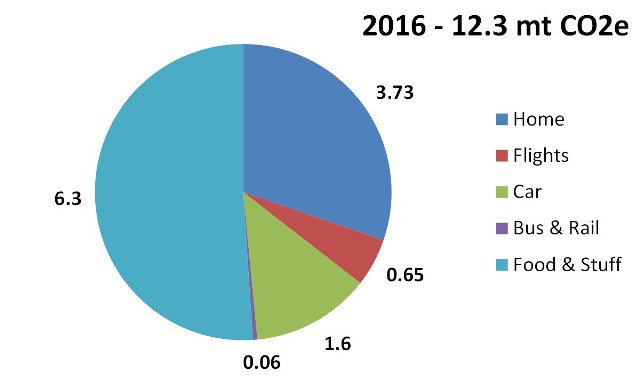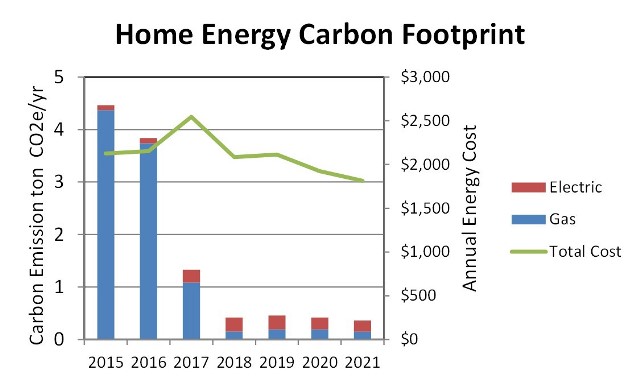Some five years ago, Bill and Lenore took an important step toward the decarbonisation of their home in Ottawa by installing a heat pump. With this new heating system, they reduced the greenhouse gas emissions from their home by an astounding 90 percent. Read their story — Reducing Your Home Carbon Footprint is Easy. Now, they’re all in.

The Heat Pump Adventure Continues
(This article was previously published in Medium.)
To answer a question I am often asked — Yes, we are still happy with the decision, five years ago, to replace our gas furnace with an air-source heat pump. It is one of the best decisions we ever made.
Living in an all-electric house was a half forgotten dream from my youth.
We are so happy that this past year we replaced our gas stove with an induction oven and shutoff our gas supply. This is the realization of a half forgotten dream from my youth. Today, I live in a totally electric home, 100 percent free from burning fossil fuels.
It has been an adventure. Back in 2017, when we made the decision to install the heat pump, no one could assure us that it would turn out all right. But, we were determined to make it work, whatever it took.
We live in a neighborhood of older homes in one of the coldest cities in the world, Ottawa, Canada. I enjoy the benefits of living within walking distance of most of the things we need. However, many of the houses lack modern amenities, including, as we were to find out, adequate insulation.

Conventional wisdom was that natural gas— a fossil fuel — is the best way to heat a house in Ottawa, especially for older homes that typically need more energy to keep warm. The monthly cost of using electricity for heating, we were told, would be way more expensive. And, air-source heat pumps simply don’t work in Ottawa’s cold climate. People told us we were crazy to even think about it.
But, Lenore and I are committed to do what we can to reduce our impact on climate change. Both of us are scientists working in the environmental field, and we know what the science says — stop burning fossil fuels. We simply could not take a pass on getting rid of our gas furnace.
Home energy use
Home energy use, mostly for heating, accounted for more than a quarter of household carbon emissions.
Our household carbon footprint, a measure of our climate impact, showed us that heating our home accounted for between one quarter and one third of our total impact. In a single step — switching from natural gas to electricity for heating — we could go a long way toward reducing our climate impact.

Over 90 percent of the electricity we purchase from the Ontario grid today is made without using fossil fuels. Electricity in most other areas has a higher fossil-fuel content, but it is typically not 100 percent. And, the fossil-fuel content of electricity is declining everywhere as electric utilities respond to the climate crisis and reduce costs by using more renewable energy sources.
So, we took the plunge on the coldest night of the winter of 2017. Our gas furnace gave out on Friday, January 13. The service company offered to have a new gas furnace delivered and installed the next day, but we refused. Instead, we embarked on a month-long process of making the switch to an air-source heat pump.
At that time, the only cold-weather heat pump available to us was the Mitsubishi Zuba. The model we have delivers 48,000 BTU per hour of heat when the outside air temperature is warmer than -15 degrees Celsius, but performance drops off when it gets colder. The Zuba delivers 80 percent of peak capacity at -25 degrees Celsius. We also installed a 60,000 BTU per hour electric resistance furnace that provides additional heat needed when temperatures get really cold and the heat pump is at its limit.

Replacing our gas furnace with a heat pump in 2017 reduced emissions without increasing annual energy costs.
Initial results were encouraging. Heating with the electric heat pump cost us about the same as we were paying to heat with natural gas. In the first full year after making the switch our total energy costs — electricity plus natural gas — were unchanged. This contradicted everything we had been told beforehand.
More importantly, the heat pump took a large bite out of our household carbon footprint. Emissions from home energy use dropped from 3.7 mt/yr (metric tons per year) to 0.55 mt/yr, a decrease of 85 percent. This reduced our total footprint by 25 percent.
Next came an energy audit
Eager to build on our success we paid for a professional energy audit to look for other things we could do to reduce our home energy use. In Canada these audits follow a standard procedure developed by NRCan, a ministry of the federal government. The audit estimated how much energy use can be reduced for a set of actions to upgrade our house.
An energy audit showed us what savings would be possible for a number of home improvements.
Our energy audit identified upgrading insulation in the walls as the action that would deliver the greatest savings in energy use. Drilling a hole through the living room wall revealed that our house was built without any insulation in the walls. This is not unusual for houses built 100 years ago.
We added blown-in cellulose insulation to the walls in 2019. This reduced the amount of electricity we use for heating by about 20 percent, close to the savings estimated by the energy audit. But, adding insulation did not have a big effect on our household carbon footprint, because our electricity is nearly fossil-free.
We are doing other things to reduce our climate impact. We drive less, and we eat more vegetarian meals, but no other single action we take will have the same impact as replacing our old gas furnace with an electric heat pump.
Conversion to electric home now complete
Five years after taking the leap of installing a heat pump we took the final step to make our home free from fossil fuels. In September 2021 we replaced our gas oven with an electric induction oven. We had replaced our gas hot water heater with a hybrid heat pump model as part of a home reno project about eight years ago. So, the new oven completed our conversion to a 100 percent electric home, and we closed our account with the gas utility.
September 2021 — we turn off the gas service and save $240 per year in connection fees.
This last step reduced our annual energy bill by about 10 percent. The cost of the gas used for cooking was negligible. The savings come from no longer paying a $20 per month customer service fee charged on top of the cost of the gas we used. And, the air in the house is cleaner without the gas oven.
In my youth, 50 years ago, new all-electric, suburban homes were being sold as the epitome of comfort and convenience — the American Dream. But, when it came time for me to move into a house of my own, the advantages of living in an older, inner city neighborhood won out.
The lure of the “new” endures. Owners of older homes who dream of reducing their climate impact quickly encounter a difficult choice. The market will tell you that drastically reducing your home’s carbon footprint requires giving up the advantages that many older homes offer and moving to a new, energy-efficient home. These homes are built to rigorous Passive House or Net-Zero standards of construction.
However, our experience shows that living in an older home need not be a barrier to realizing your dreams. Converting an older home to run on 100 percent electricity can be done even where climate and conventional wisdom are a challenge.
Making buildings more energy efficient is a move in the right direction, but energy efficiency is not the solution to the climate crisis. To stop climate change, we must stop burning fossil fuels entirely.
Previous Heat Pump post by William Nuttle: Reducing Your Home Carbon Footprint Is Easy.
ICYMI:
Canada pushes the Fossil Path Again: Full Speed Ahead on Blue Hydrogen
Capping Oil and Gas Emissions: Production Cuts Are Essential
Senator Rosa Galvez Pushing For Climate-Aligned Financial Sector
This work is licensed under a Creative Commons Attribution-NonCommercial 4.0 International License.

















Great article….hope it spurs more people to take this action. We’ve been heat pump users since 1989….first one served us well for 30 years , heating our home until -5C outside before the furnace had to come on. Our new one now heats our home until -25C outside, which rarely happens in our winters anymore. Allowed us to get rid of our furnace altogether. Both our heat pumps provided air conditioning in summertime, with this new one barely taking any electricity to operate compared with the previous one.
Thanks for sharing your experience with heat pumps. I did not realize one could get a heat pump way back in 1989. We’re getting one sometime soon, next spring at the latest. The issue now is waiting for installers – everything is so backed up.
Hydroelectricity only accounts for 59.3 per cent of the country’s electricity supply. Other sources include coal, uranium, natural gas, petroleum and non-hydro renewable sources.
We don’t have a carbon-free option yet!
Thank you for joining the Below2C community and thank you for the feedback to the article.
Perhaps we don’t yet have a carbon-free option but low-carbon is possible with a heat pump with electric backup. That’s what I hope to do soon.
we have used a Mitsubishi Zuba Central heat pump in our house for 4 years in Fort Smith NT north of 60.
We have the built in electric back up and it kicks in at -30C.
It is a beautiful air conditioner in the summer and we have left our home for months at a time in the winter. We do have a wood stove which we love to run and which is still the least expensive option because our ELE trial costs are .25 cents per kwh
Dennis – welcome to Below2C.
Thank you for sharing your positive heat pump experience from Fort Smith. I’m getting one put in in Ottawa where -30C is quite infrequent.
Thanks for the feedback.